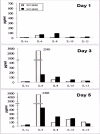Molecular events associated with epithelial to mesenchymal transition of nasopharyngeal carcinoma cells in the absence of Epstein-Barr virus genome
- PMID: 19930697
- PMCID: PMC2799403
- DOI: 10.1186/1423-0127-16-105
Molecular events associated with epithelial to mesenchymal transition of nasopharyngeal carcinoma cells in the absence of Epstein-Barr virus genome
Abstract
Epithelial-mesenchymal transition (EMT) is an important process in tumor metastasis. The EMT-related events associated with metastasis of NPC in the absence of EBV have not been elucidated. We established an EBV-negative NPC cell line from a bone marrow biopsy of an NPC patient. Using a Matrigel system we isolated an invasive and non-invasive sublines, designated NPC-BM29 and NPC-BM00. NPC-BM29 acquired an invasive-like phenotype characterized by EMT, marked by down-regulation of E-cadherin and beta-catenin with concomitant increased expression of Ets1. NPC-BM29 cells expressed >or= 10-fold higher of MMP-9 than NPC-BM00 cells. NPC-BM29 cells grew better in 2% serum than NPC-BM00 cells, with a population doubling-time of 26.8 h and 30.7 h, respectively. A marked reduction in colony-formation ability of NPC-BM00 cells compared to NPC-BM29 was observed. Wound-healing assay revealed that NPC-BM29 cells displayed higher motility than NPC-BM00 and the motility was further enhanced by cell treatment with TPA, a PKC activator. Cell surface markers and tumor-associated molecules, AE3, MAK6 and sialyl-Tn, were up-regulated in NPC-BM29 cells, whereas the expression of HLA-DR and CD54 was significantly increased in NPC-BM00 cells. NPC-BM29 consistently released higher levels of IL-8 and IL-10 than NPC-BM00, with low levels of IL-1alpha expression in both cell lines. Higher level of VEGF production was detected in NPC-BM00 than NPC-BM29 cells. These data show that EBV is not required for exhibiting multiple metastatic phenotypes associated with EMT. More studies that target right molecules/signalings associated with the EMT may offer new therapeutic intervention options for NPC invasion and metastasis.
Figures











References
-
- Rickinson AB, Kieff E. In: Fields Virology. 3. Fields BN, Knipe DM, Howley PM, editor. Philadelphia; Lippincott-Raven; 1996. Epstein-Barr virus; pp. 2391–2246.
-
- Lin JC. In: New Developments in Epstein-Barr Virus. Umar CS, editor. New York; Nova Science Publishers, Inc; 2006. Pathogenesis and therapy of Epstein-Barr virus infection: Novel therapeutic approaches; pp. 1–35.
-
- Ortiz-McWilliams JO. In: Head and Neck Oncology. 1. Myers EM, editor. Boston; Little-Brown; 1991. History and physical examination; pp. 19–43.
-
- Pagano JS, Blaser M, Buendia MA, Damania B, Khalili K, Raab-Traub N, Roizman B. Infectious agents and cancer: criteria for a causal relation. Semin Cancer Biol. 2004;14:453–71. - PubMed
Publication types
MeSH terms
LinkOut - more resources
Full Text Sources
Research Materials
Miscellaneous

